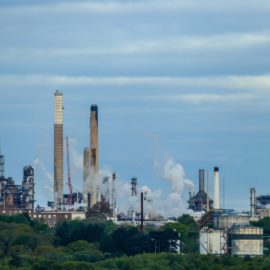
New Mexico Environment Department
It is a bird! It is a plane! No, it is a helicopter over head and we got caught with a violation.
The rare use of high-tech helicopter surveillance has led to federal pollution violation notices for a list of Louisiana oil and gas facilities, documents and officials say, with the inspections having targeted a wide range of plants throughout the state. The overflights using an infrared detection camera occurred in 2021, but have only recently come to light publicly through federal Environmental Protection Agency document filings. It’s the first time EPA has conducted a broad survey of air pollution at plants across the state using helicopters, said an EPA spokesperson. The flights targeted six regions of the state, including the Mississippi River chemical corridor between New Orleans and Baton Rouge, rural areas as far north as Shreveport, as well as Lafayette, Morgan City and Lake Charles. The EPA spokesperson said the agency decided to expand the program after judging previous similar checks in New Mexico and Texas to be successful.
nola.com
Nine violations have been noted in Louisiana.
The EPA has so far handed out nine violation notices to oil and gas companies operating in Louisiana after the surveillance flights recorded emissions of volatile organic chemicals. The surveillance helicopter monitored more than 150 facilities between Aug. 14 and Sept. 24, 2021, said EPA spokesman Joseph Robledo. The company conducting the surveillance wasn’t named. “The helicopter … surveyed 5,181 tanks, 226 flares, and 62 other sources for leaks and emissions,” Robledo said. “Hydrocarbon emissions were detected from approximately 47 unique sources at 29 different facilities. Some emissions were permitted, some were unauthorized.” The helicopter flew about 200 feet above ground level and made video recordings with a Forward Looking Infrared Radiometer, or FLIR, which is an optical gas imaging camera.
The offenders were sent a letter and for some, a site visit was done.
EPA sent notification letters and received responses from all 29 facilities where emissions were detected, he said. In some cases, on-site inspections and off-site compliance evaluations were conducted. EPA would not release the letters and responses, and has turned down a request by The Times-Picayune | The Advocate for early release of those and other records about the survey under the federal Freedom of Information Act. It said the paper hadn’t shown that not releasing them “would pose an imminent threat to the life or physical safety of an individual.” However, notices of violations issued between May and December 2022 to nine of the facilities, owned by seven different companies, were recently posted to an EPA public database. Those notices provided each facility an opportunity to confer with EPA before it determined whether fines should be levied.
Texas and New Mexico were also surveyed.
The flyovers followed similar surveys in Texas and New Mexico dating back to 2019, when helicopters surveilled more than 1,800 emission sources to identify 197 with potentially unauthorized emissions. Last year, EPA also targeted potential methane emissions in the Permian Basin in Texas with similar flyovers. EPA officials worked with the Louisiana Department of Environmental Quality to determine which facilities are significant sources of volatile organic compounds and hazardous air pollutants, two categories of emissions regulated by both EPA and the state. It then informed DEQ about the areas that would be surveyed, Robledo said. A DEQ spokesperson said officials there have not heard anything more about the surveillance effort from EPA since December 2021, other than receiving copies of responses sent to EPA by the companies.

(Google Earth)
There were sites that had violations.
The EPA violation notices cited each company for violation of Louisiana regulations limiting the emission of organic compounds, requiring use of best practical housekeeping and maintenance standards, or allowing release of emissions by failing to keep emergency flares lit: Bayou Bouillon Operating LLC production facility near Butte LaRose. Emissions from unlit flare, from the top of a large tank, and from piping. Muammer Alboamemah, head of operations for the company, said his company has resolved the issues with EPA through a variety of actions, including making sure tanks, flares and vessels are checked for improper venting twice a day, checking control valves, adding a second flare and improving the flares’ equipment, and hiring a petroleum engineer to oversee environmental compliance.

(Google Earth)
Columbia Gulf Transmission Company – Rayne Compressor Station. Leak from a pipeline liquids tank releasing hydrocarbon emissions. Columbia Gulf entered into a consent agreement on Aug. 24 requiring it to cease use of the tank, modify its state permit, and pay a $57,968 fine. A spokesperson for TC Energy, which owns the Columbia Gulf Rayne Compressor Station, said the EPA concerns were resolved through the consent agreement, and that the company continues to monitor its pipeline systems around the clock.

(Google Earth)
ETC Field Services, LLC – Dubach Cryogenic Plant. Leaks from two safety vent stacks releasing hydrocarbon emissions.

Aerial view of Harvest Midstream’s Kaplan Gas Plant. EPA helicopter surveillance spotted emissions from four storage tanks and the company was cited for not installing a system to capture the emissions.
(Google Earth)
Harvest Midstream Co. – Kaplan Gas Plant. Failure to install a vapor recovery system and direct vapors to a gas system or a control device to reduce aggregated facility flash gas emissions by a minimum of 95 percent, and leaks from four storage tanks releasing hydrocarbon emissions.

(Google Earth)
John W. Stone Oil Distribution, LLC – Gretna terminal. Leak from a tank releasing hydrocarbon emissions, and failing to control emissions from that tank with a required oxidation unit. A spokesperson for the company said it does not comment on active investigations.

(Google Earth)
Kinetica Deepwater Express – Patterson terminal. Leaks from a storage tank releasing hydrocarbons. A spokesperson for Kinetica said the facility was damaged during Hurricane Ida on Aug. 29, 2021, and the EPA flyover occurred soon after. An inspection in October found no leaks, but a leaking seal was later found and its repair was completed on Dec. 10.

(Google Earth)
Texas Petroleum Investment Co. Weeks Island East Facility in Iberia Parish. Leaks from seven storage tanks releasing hydrocarbon emissions into the air; Weeks Island Central Facility, emissions from an unlit emergency control flare; Weeks Island West Facility in Iberia Parish, leaks from a 1,500-barrel oil storage tank and a 2,000-barrel water storage tank releasing hydrocarbon emissions into the air. David Margulies, a spokesperson for Texas Petroleum, said the company was committed to working with regulators to protect the environment. “Each of the emissions issues identified at our Weeks Island facility were addressed in 2021 and were resolved at that time,” he said.
This should mean more violations will be caught, a good thing for keeping the air cleaner.



